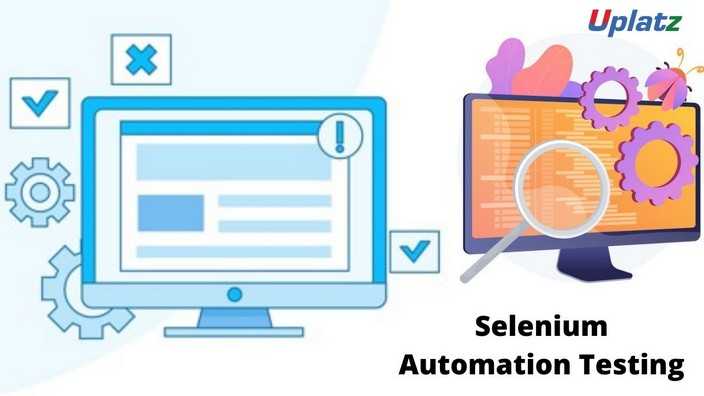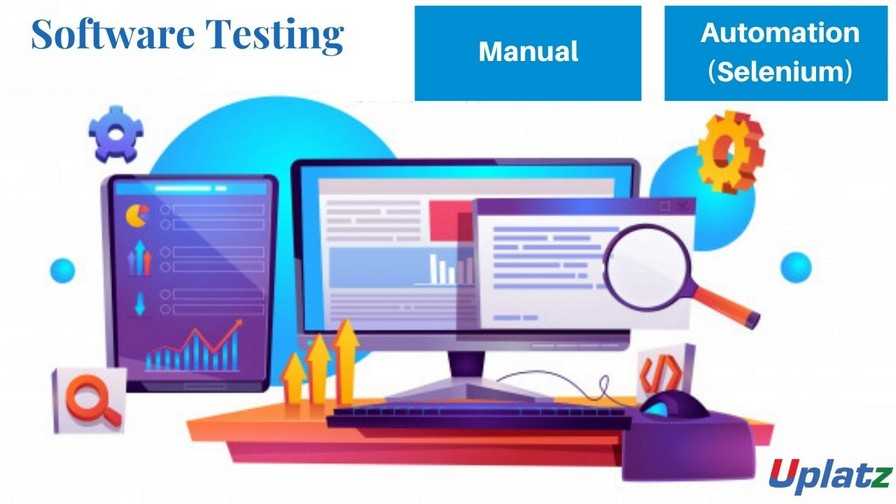Overview Course - Software Testing
ou will learn black box and white box testing, automated testing, web & mobile testing, and formal testing with theory and techniques. View Course Curriculum
Price Match Guarantee
Full Lifetime Access
Access on any Device
Technical Support
Secure Checkout
Course Completion Certificate
View Course Curriculum
Price Match Guarantee
Full Lifetime Access
Access on any Device
Technical Support
Secure Checkout
Course Completion Certificate
 80% Started a new career
Enroll Now
80% Started a new career
Enroll Now
-
 85% Got a pay increase and promotion
85% Got a pay increase and promotion
Students also bought -
-

- Software Testing (Automation Testing with Selenium)
- 30 Hours
- GBP 12
- 2519 Learners
-

- Software Testing (Manual Testing)
- 30 Hours
- GBP 12
- 1554 Learners
-

- Bundle Combo - Software Testing (Manual and Automation)
- 50 Hours
- GBP 22
- 555 Learners

This is an overview course on Software Testing while the complete detailed-level Software Testing course is available at -
1. Software testing - https://training.uplatz.com/online-it-course.php?id=software-testing-108
2. Software Testing – Automation Testing with Selenium - https://training.uplatz.com/online-it-course.php?id=software-testing---automation-testing-with-selenium-361
3. Software Testing - Manual Testing - https://training.uplatz.com/online-it-course.php?id=software-testing---manual-testing-360
In this course of software testing, you will learn about basic of skills and Software Testing concepts. Software Testing is a main part of the life cycle of software development. It gives valuable information to companies and stakeholders about the quality of a product or service. Sometimes that software or service is brand new and at risk of software bugs or somewhere in the middle of the development process. And sometimes it's an established software or service in need of a change.
Through this Course and Certification, you can build your skills in various testing capacities. Uplatz’s Software Testing course builds fundamental skills such as object-oriented programming/testing and Agile methods. It also offers Software Testing Fundamentals designed to equip you for the testing lifecycle. You can also take courses that will teach you the fundamentals of security testing, agile testing, static testing, and even state of the art property testing.
This Software Testing overview course also explain how you can automate some of the testing methodologies & tools, reducing the need for manual testing which can shorten the development process. Test data is a vital part of the release plan, and missing requirements could derail everything.
SOFTWARE TESTING
Topic 1:
Basic concepts
• Basic Testing Vocabulary
• Quality Assurance versus Quality Control
• The Cost of Quality
• Software Quality Factors
• How Quality is Defined
• Why Do We Test Software?
• What is a Defect?
• The Multiple Roles of the Software Tester(People Relationships)
• Scope of Testing
• When Should Testing Occur?
• Testing Constraints
• Life Cycle Testing
• Independent Testing
• What is a QA Process?
• Levels of Testing
• The “V” Concept of Testing
Topic 2:
Testing Techniques
• Structural versus Functional Technique Categories
• Verification versus Validation
• Static versus Dynamic Testing
• Examples of Specific Testing Techniques
Test Administration
• Test Planning
• Customization of the Test Process
• Budgeting
• Scheduling
Create the Test Plan
• Prerequisites to test planning
• Understand the Characteristics of the Software Being Developed
• Build the Test Plan
• Write the Test Plan
Topic 3:
• Test Cases:
• Test case Design
• Building test cases
• Test data mining
• Test execution
• Test Reporting
• Defect Management
• Test Coverage – Traceability matrix
Test Metrics – Guidelines and usage
Test reporting: Guidelines for writing test reports
Topic 4:
Test Tools used to Build Test Reports
Managing Change
• Software Configuration Management
• Change Management
Risks – Risk Analysis and Management with examples
User Acceptance testing – in detail explanation with details
Case Study: How to test web, stand alone and database applications – with examples.
Help with resume and testing interview skills.
Topic 5:
Automation Testing Basics
• Basics of automation testing – why, when and how to perform automation testing
• Factors for choosing a particular tool
• An overview for the major functional testing tools
• Overview of Test management and bug tracking tools
The Software Testing Certification ensures you know planning, production and measurement techniques needed to stand out from the competition.
Software testing is the process of evaluating and verifying that a software product or application does what it is supposed to do. The benefits of testing include preventing bugs, reducing development costs and improving performance. Test management plan.
Basically, software testing helps not only to discover defects in software, but also its configuration. Through testing, developers are able to determine the reliability of the software. Any product can be turned into a strong and consistent product with the help of testing in software development.
SDLC or the Software Development Life Cycle is a process that produces software with the highest quality and lowest cost in the shortest time possible. SDLC provides a well-structured flow of phases that help an organization to quickly produce high-quality software which is well-tested and ready for production use.
Certified Software Tester certification assures a professional-level competence in the principles and practices of quality control (QA). The CSTE certification is apt for bagging the role of a software testing or quality control advisor and quality control manager.
Uplatz online training guarantees the participants to successfully go through the Software Testing Certification provided by Uplatz. Uplatz provides appropriate teaching and expertise training to equip the participants for implementing the learnt concepts in an organization.
Course Completion Certificate will be awarded by Uplatz upon successful completion of the Software Testing online course.
The Software Testing draws an average salary of $125,000 per year depending on their knowledge and hands-on experience.
Software Testing is a highly sought-after position in the tech industry. Their primary job is to continually test the software to find defects, called bugs, and report any defects they find into a tracking system.
Testing is seen as a good professional career for many. From being a test engineer, one can grow to become a senior test engineer, from a test lead to a test manager; or alternatively, one can become a QA lead or QA Manager. Moreover, the options available on the testing tools side are vast.
Note that salaries are generally higher at large companies rather than small ones. Your salary will also differ based on the market you work in.
Manual software tester
Quality Analyst.
Sr, Software tester.
1. 1. What is Software Testing?
Software testing is the act of operating a system or application under control and then assessing their results. It is intentionally simulating a problem situation in order to work out a possible remedy in case a situation like that actually happens.
2. What kind of testing should we consider?
The basic testing to consider include Blackbox testing, Integration testing, Whitebox testing, User acceptance testing, Load testing, Acceptance testing, Performance testing, and Smoke testing.
3. What is Software ‘quality’?
Quality software is software that is reasonably free from bug, is up to the requirements and/or expectations, delivered on time and according to the budget, and is easy to maintain.
4. What is ‘Software Quality Assurance’?
Software Quality Assurance also known as Software QA, encompasses the entire process of developing software: observing and improving the process, seeing that the standards and procedures agreed upon are followed, and making sure that problems are discovered and also fixed.
5. Does every software project need testers?
This solely depends on the context or size of the project, the methodology of development, risks involved, and the experience and skills of the developers. Generally, every project would need testers, except in some cases. A project that is non-trivial sized or with non-trivial risks would need a testing staff. But whereby the project is for a short term, low risk, small, and with programmers that are highly experienced that are making use of test-first development or unit testing, such project may not need a test engineer for it to do well.
6. What is verification? And what is validation?
Verifications are reviews and meetings which are intended to help evaluate documents, code, specifications, and requirements. It is usually done with checklists, walkthroughs, issues lists, and inspection meetings.
Validation, on the other hand, entails the real testing and it is done after completing the verification.
7. What is Regression testing?
This is the act of retesting a program that has been tested previously in order to be sure that there has not been any fault following the modification or that no new fault has been introduced.
8. What is a ‘test plan’? What is a ‘test case’?
A software project test plan is a document that explains the objective, approach, focus, and scope of a software testing. A test case, on the other hand, is a document that explains an action, input, or event, and a response that is expected, to help decide if an application’s feature is functioning properly.
9. Why does software have bugs?
Software has bugs for the following reasons
· Errors in programming
· Lack of communication or no communications at all
· Requirements changes
· Time pressures
10. What should you do after finding a bug?
You need to report the bug and then assign it to developers that can take care of it. When you have fixed the problem, retest the fixes, decide the requirements for regression testing in order to be sure that no more problems are eventually caused by the fixes.
11. How can you introduce new Software QA processes to an existing Organization?
This is usually determined by the organization’s size as well as the risks involved. If it is a small project or group, it may be better to use a more ad-hoc process, depending on the customer and project type. It can also be done via incremental self-managed team approaches.
12. What are 5 common problems in the software development process?
· Schedule that is unworkable
· Requirements changes
· Inadequate communication
· Insufficient testing
· Poor requirements
13. What are the 5 common software development problems solutions?
· Schedule that is practicable
· Clear communication among the project team members
· Firm requirements
· Clearness of requirements
· Sufficient testing
14. What steps are needed in developing and running software test?
· Get the requirements, functional design, and plan for the internal design, and other documents that are relevant.
· Get budget and the schedule conditions
· Decide project framework
· Recognize risks
· Decide testing approaches, process, test setting, test data
· Carry out test
· Carry out reviews and evaluations
· Sustain and keep documents up to date
15. What is the best software test estimation approach?
This is determined by the organization, the type of project, and the experience of the involved personnel. However, here are a few approaches to consider:
· Metrics-Based Approach
· Implicit Risk Approach
· Percentage-of-Development Approach
· Test Work Breakdown Approach
· Iterative Approach
16. How does a client/server environment affect testing?
Client/server applications are sometimes complex as a result of the multiple dependencies among clients, communication of data, server, and hardware, particularly multi-tier systems. Stress/load/performance testing can help to determine the capabilities and limitations of client/server application.
17. What are the attributes of a good software QA engineer?
They should be able to comprehend the whole process of software development and how it blends with the organization’s goal and the business approach. Diplomacy and patience are highly required in the early phases of QA processes implementation. For inspections and reviews to be successful, ability to identify problems and spot ‘what is missing’ is a must.
18. What information does a test strategy capture?
It captures the general approach’s explanation to be used as well as the testing styles, specific types, and techniques.
19. How can we test World Wide Web sites?
Things to consider might include:
· Testing the HTML specification, internal and external links
· Testing the server’s expected loads
· Testing the securities needed to be implemented and verified
· The applets, ActiveX components, cgi programs, javascript, etc that you need to track, maintain, and control
· Performance that you should anticipate on the side of the client.
20. What is extreme programming and what has it got to do with testing?
Extreme programming otherwise known as ‘XP’ is a software development step taken by small teams working on projects that are susceptible to risk and also have requirements that are not steady. To carry out extreme testing, it is expected that the programmers should first write unit and functional test codes before the application code is written. It is also important to make the customer an important part of the project team and assist in developing scenarios that would enable you to conduct acceptance/black box testing.
21. What is ‘good code’? What is ‘good design’?
‘Good code’ is a code that works well, has no bug, can be read, and can be maintained. Good internal design signifies a software code with a clear, understandable, modifiable, and maintainable overall structure. It has to be robust with the capacity for adequate error handling and status logging and works properly when it is executed. Good functional design refers to an application with a functionality that one can trace back to the requirements of the end-user and customers.
22. How can you know when to stop testing?
The following factors determine when to stop testing:
· Deadlines such as testing deadlines, release deadlines, etc are met
· Test cases are completed with ‘pass’ in certain percentage
· Exhaustion of test budget
· Coverage of code/requirements/functionality attains a specified point
· A drop in the rate of bug below a certain level
· An end of the beta or alpha testing phase
23. What if there is not enough time for detailed testing?
· Decide where to focus the testing with the help of risk analysis
· Decide which important functionality is to be tested
· Establish the aspects of the project that are high-risk
· The kinds of test to be performed have to be prioritized
· The tests to have the best high-risk-coverage to time-required ratio have to be decided.
24. What is the main objective when reviewing a software deliverable?
To discover fault in any software work product
25. What determines the level of risk?
The level of risk is determined by the likelihood of an adverse event and the impact of the event
26. What is the benefit of test independence?
It prevents the partiality of the author in defining effective tests.
27. What is SEI? CMM? CMMI? ISO? Will it help?
They are all standards that decide effectiveness in quality software delivery. They help organizations in identifying best practices that are valuable in assisting them in increasing the maturity of their processes.
28. What is integration testing?
This is the testing carried out to be sure of the accurate operation of the components in the implementation model when combined to execute a use case.
29. What is developer testing?
Developer testing refers to the aspect of test design and implementation that the team of developers considers most appropriate to undertake.
30. What is system testing?
It is the series of tests aimed at making sure that the modified program is able to interact properly with other components of the system.









